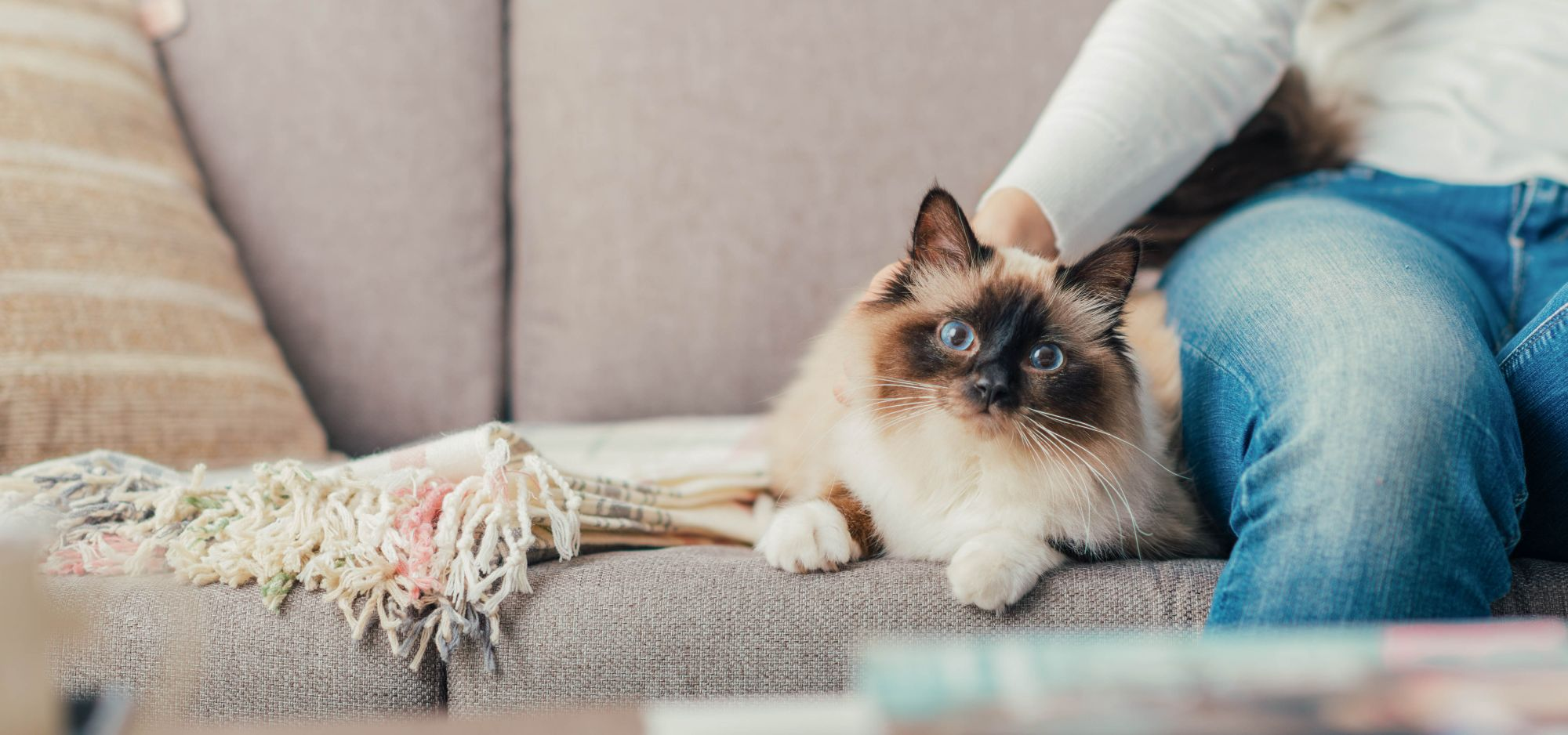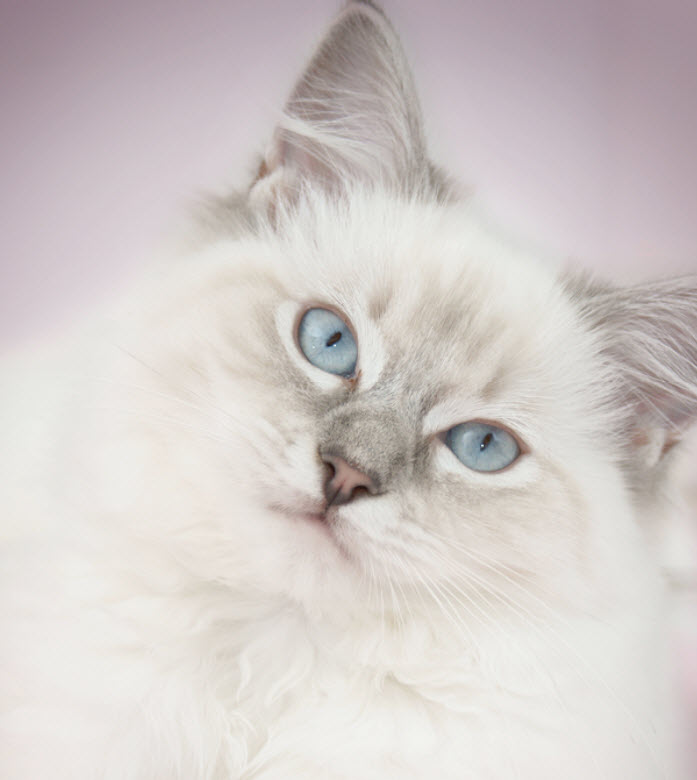To determine if a Ragdoll cat is overweight, check for excess fat around the abdomen and a lack of a waistline. An ideal Ragdoll should have a slight abdominal tuck and ribs that are palpable with a slight fat covering.
Caring for a Ragdoll cat involves monitoring its weight to ensure a healthy lifestyle and minimize health risks. These fluffy felines are prone to obesity, which can lead to serious health problems. It’s crucial for Ragdoll owners to be aware of their pet’s body condition and take action if their cat starts to tip the scales.
Identifying weight issues early on can help prevent complications such as diabetes, arthritis, and heart disease. Keeping your Ragdoll at an appropriate weight through diet management and regular exercise promotes longevity and a better quality of life. Regular vet visits and weight check-ins are essential components of maintaining your feline friend’s health.

Credit: www.royalcanin.com
Ragdoll Cats And Weight Management
Ragdoll Cats and Weight Management – a topic of paramount importance for these calm and affectionate felines. Known for their laid-back nature, it’s easy for Ragdoll cats to slip into a sedentary lifestyle, leading to weight issues. Vigilant pet owners can ensure the enduring health of their furry friends by understanding how to maintain an ideal weight for these gentle giants.
Characteristics Of Ragdoll Cats
Ragdolls are distinguished by their striking blue eyes, semi-long coat, and large, muscular frame. Their gentle and friendly temperament makes them a favorite among cat enthusiasts. Yet, their larger size can often disguise weight gain, making it crucial to recognize the normal physique of a healthy Ragdoll cat.
- Large, blue eyes and a soft, semi-long coat
- Muscular, sturdy body with a broad chest
- Average weight ranges from 10 to 20 pounds
Importance Of Weight Control In Ragdolls
Weight control is vital for the health and well-being of Ragdoll cats. Excess weight can lead to a slew of health issues including diabetes, heart disease, and joint pain. With their calm demeanor, Ragdolls may not seek out exercise, so it is up to their owners to incorporate activity into their routine.
| Weight Management Benefits | Problems with Excess Weight |
|---|---|
| Improved joint health | Increased risk of diabetes |
| Enhanced mobility | Heart disease likelihood |
| Longer life expectancy | Potential for joint pain |
A balanced diet and regular exercise play key roles in managing a Ragdoll cat’s weight. Regular checkups with the vet to monitor their weight are also essential. Identify and maintain the ideal weight to ensure a happy, healthy life for your Ragdoll cat.

Credit: www.reddit.com
Identifying An Overweight Ragdoll
Identifying an overweight Ragdoll cat is crucial for your fluffy friend’s health. Ragdolls are known for their gentle demeanor and plush coats, making it sometimes tricky to spot extra pounds beneath all that fur. Regular check-ups and weighing can prevent health issues associated with excess weight.
Body Condition Scoring For Cats
Body condition scoring (BCS) is a reliable method to assess your Ragdoll’s weight. Using a scale from one to nine, five is ideal. Below is a guideline for scoring:
- 1-3: Underweight
- 4: Slightly underweight
- 5: Perfect weight
- 6: Overweight
- 7-9: Obese
Signs Of Excess Weight In Ragdolls
Here are some signs that your Ragdoll may be carrying extra weight:
- Less Visible Waistline: View your cat from above. Is there a waist? If not, your cat might be overweight.
- Touch Test: Can you feel the ribs easily? They should be noticeable, but not protruding. Difficulty in feeling the ribs suggests excess fat.
- Heavy Breathing: Overweight cats often show labored breathing after minimal activity.
- Less Active: If your Ragdoll shows reluctance to play or move, weight could be a factor.
- Overeating: Does your Ragdoll always seem hungry or is eating more than usual? Portions could need adjusting.
Ragdolls tip the scales more than some other breeds due to their larger frame. It’s essential to know what is normal for your specific pet. Your vet can provide insight into what a healthy weight looks like for your furry companion. Follow their guidelines closely.
Factors Contributing To Weight Gain
Factors Contributing to Weight Gain in Ragdoll cats can often sneak up on pet owners. These laid-back felines are prone to piling on extra pounds without obvious signs. Understanding these factors can help prevent and manage their weight effectively.
Diet And Feeding Habits
What and how much your Ragdoll eats play a crucial role in weight control. High-calorie diets or frequent treats can lead to weight gain. Feeding habits such as free-feeding can also contribute, as it allows cats constant access to food. Instead, a structured feeding schedule with measured portions can encourage a healthier weight.
- Avoid human food – it’s often too rich for cats.
- Read labels on cat food for calorie information.
- Measure meals to prevent overfeeding.
- Limited treats to reduce extra calorie intake.
Exercise And Activity Levels
Ragdolls are known for their docile personalities, which can lead to low activity levels. A lack of exercise means fewer calories burned, and as a result, weight gain. Ensuring daily playtime can keep your cat active and help maintain a healthy weight.
| Activity | Frequency | Duration |
|---|---|---|
| Interactive Play | Daily | 15-20 mins |
| Puzzle Toys | Regularly | Varies |
| Exploration | Often | 30 mins |
Remember, each Ragdoll cat is unique. Monitor your pet’s individual needs and adjust their diet and exercise accordingly. Keeping your Ragdoll at a healthy weight is crucial for their overall wellbeing.

Credit: www.craiyon.com
Health Risks Associated With Obesity
Ragdoll cats, known for their luxurious coats and gentle demeanor, are not immune to the dangers of excess weight. Obesity can lead to various health issues that compromise both their quality of life and longevity. Understanding what these risks are is crucial for any Ragdoll parent.
Common Health Issues In Overweight Ragdolls
Being overweight affects Ragdoll cats in multiple ways. Here are some common complications:
- Diabetes: Excess fat affects insulin use in cats.
- Joint Problems: Extra weight strains joints, causing pain.
- Heart Disease: Obesity forces the heart to work harder.
Long-term Effects Of Obesity On Cat Health
Long-term obesity in Ragdoll cats can lead to:
- Shortened lifespan: Excess weight can trim years off their life.
- Decreased mobility: Overweight cats move less, compounding health troubles.
- Liver issues: Fat can accumulate in the liver, leading to hepatic lipidosis.
| Health Risk | Explanation | Preventative Measures |
|---|---|---|
| Urinary Tract Diseases | Heavier weight can cause urinary complications. | Maintain proper weight through diet and exercise. |
| Respiratory Difficulties | Obese cats may struggle to breathe properly. | Monitor weight closely, seek veterinarian care when needed. |
Weight Management Strategies
Managing a Ragdoll’s weight is crucial for a healthy, happy feline. Ragdolls are prone to obesity, which can lead to other health concerns. Let’s explore effective strategies to keep Ragdoll cats in tip-top shape.
Creating A Tailored Diet Plan
Cats have unique dietary needs, and Ragdolls are no exception. Start with the basics: high-quality cat food labeled “complete and balanced.” The right food should suit their age, size, and activity level.
- Measure meals. Use a measuring cup for accurate portions.
- Split the daily intake. Offer smaller, frequent meals.
- Limit treats. Treats should be less than 10% of their diet.
- Consider wet food. It’s often lower in calories and more satisfying.
| Age | Daily Calories | Type of Food |
|---|---|---|
| Kitten | 200-250 | High-energy kitten formula |
| Adult | 250-300 | Balanced adult cat food |
| Senior | 200-250 | Lower-calorie senior food |
Always consult your vet for personalized advice. Every Ragdoll’s needs can vary.
Implementing A Regular Exercise Regime
Exercise is vital for your Ragdoll’s well-being. Regular activity helps manage weight and stimulates their mind. Here’s how to get your cat moving:
- Use cat trees. Encourage climbing and exploring.
- Interactive toys. Engage with laser pointers or feather wands.
- Set playtime. Dedicate 10-15 minutes, twice a day.
- Catnip or treats. Use them as incentives for activity.
Play sessions aren’t just fun; they foster bonding and a sense of well-being. Record your cat’s activity and adjust as needed to prevent boredom or overexertion.
Consulting The Professionals
Consulting the Professionals is a crucial step in ensuring the health of your Ragdoll cat. Obesity can lead to severe health issues. Therefore, identifying whether your feline friend is overweight is paramount. Despite our best efforts, sometimes professional help is needed. Experts can offer insights and tailor solutions for your pet’s weight concerns.
When To Seek Veterinary Advice
Knowing when to consult a vet is vital. Look out for these signs:
- Limited mobility or lethargy
- Difficulty in grooming themselves
- Visible weight gain
A vet can provide a thorough health assessment. They use body condition scoring to determine the right weight. If needed, the vet will recommend a weight reduction plan.
Working With A Pet Nutritionist
Pet nutritionists are crucial in the fight against feline obesity. They offer expertise in:
- Assessing dietary needs
- Creating balanced meal plans
- Recommending food types and portions
They may suggest specialized diets tailored to your Ragdoll’s needs. Their advice helps maintain a healthy weight. Together with your vet, they form a support team for your pet’s well-being.
Frequently Asked Questions On How To Tell If Ragdoll Cat Is Overweight
How Do I Know If My Ragdoll Is Overweight?
Check your Ragdoll’s weight with a vet-recommended scale. Observe body shape; an overweight cat may lack a visible waist and have a rounded abdomen. Feel for excess fat, since a healthy Ragdoll should have a slight padding over their ribs.
Monitor their activity levels and look for signs of labored movement.
Do Ragdolls Get Fat Easily?
Ragdoll cats can gain weight easily due to their laid-back nature and tendency for less physical activity. Proper diet and exercise are crucial to maintain their health.
What Is A Healthy Weight For A Ragdoll Cat?
A healthy weight for a Ragdoll cat typically ranges from 10 to 20 pounds. Males often weigh between 15 to 20 pounds, while females average 10 to 15 pounds.
Do Ragdoll Cats Have Big Bellies?
Ragdoll cats often sport a noticeable primordial pouch, which can give them a larger-bellied appearance. This pouch is a normal part of their physique.
Conclusion
Monitoring your Ragdoll’s weight is crucial for their health. Regular checks and a proper diet can prevent obesity-related issues. Consult your vet for tailored advice and ensure your fluffy companion leads a happy, active life. Remember, a healthy Ragdoll is a joy forever.
Keep an eye on their well-being!



